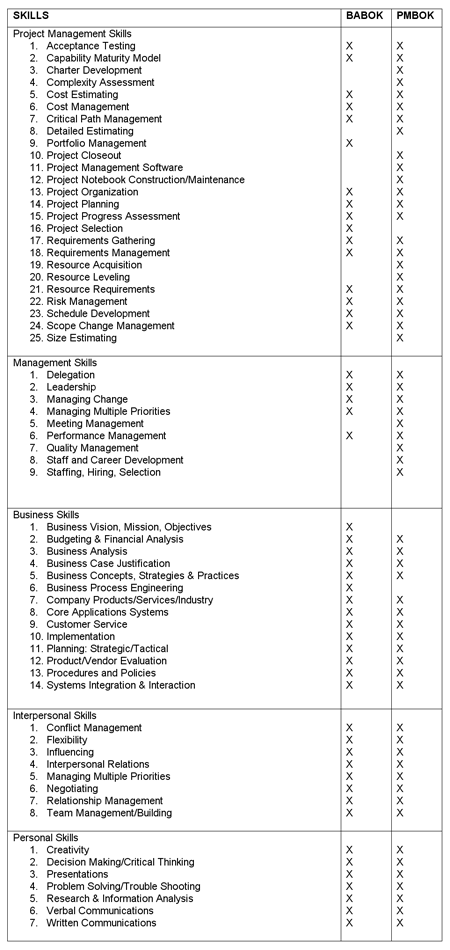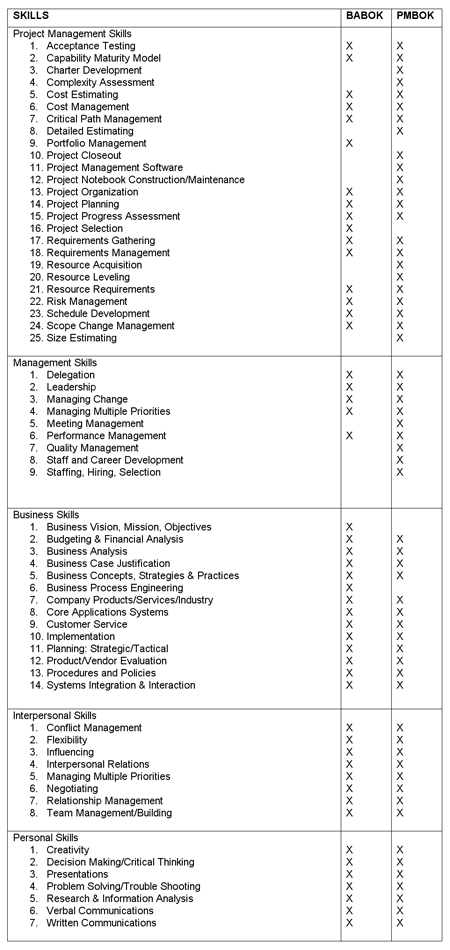
An Examination of BA and PM Skills Profiles
In the previous article I set the stage for additional comments on the inevitability of the morphing of the business analyst (BA) and project manager (PM) into a single professional that I labeled the “BA/PM” for lack of an appropriate position title. Requirements gathering and management was the thread in that article that inextricably links the BA and the PM in the Agile Project World.
In this article I want to look under the hood of this new professional that I am calling a BA/PM. Using the PMI PMBOK and the IIBA BABOK I will list the skill and knowledge profiles of the BA and the PM. A comparison of those two profiles will show remarkable similarity between the two. This should come as no surprise to anyone and will further support the creation of the BA/PM professional, at least in the agile project space if not the entire project space.
My hope is that I will have captured your interest and attention enough for you to share your thoughts and ideas whether you agree with me or not. I welcome opposing positions and the opportunity to engage in public discussions.
BA and PM Skills and Competencies
The following table presents a high-level comparison of the skills and knowledge of the BA and the PM as derived from the BABOK and the PMBOK.

Is it any surprise that the two lists are nearly similar? From the perspective of the BA all of their work is done as part of a project and so they must have all the skills of a PM to match the complexity of the projects they manage. From the perspective of the PM, not all of their projects will have a BA component but they must have at least a working knowledge of the BA skills.
Assessing Proficiency Levels
Once a BA/PM position family is in place, the BABOK and PMBOK columns will be replaced with the position family, and the column check marks will be replaced by the minimum proficiency levels as defined by Bloom’s Taxonomy, which is shown below:
Level 0: I never heard of it.
Level 1: I can define it.
1 Familiar with the terminology
2 Understands the basic concepts
Level 2: I understand what it can do.
1 Knows how it is used
2 Can explain key issues and benefits
3 Understands organizational relevance
Level 3: I have limited hands-on experience.
4 Has a working knowledge of basic features and functions
5 Aware of relevant standards, policies and practices
6 Requires assistance and supervision
7 Can apply it in a limited (homogeneous) environment
Level 4: I have extensive hands-on experience.
8 Knowledge of operational issues and considerations
9 Understanding of benefits and drawbacks
10 Working knowledge of relationships and integration
11 In-depth knowledge of major features, functions and facilities
12 Awareness of usage in other environments
13 Can work without assistance or supervision
Level 5: I can adapt it to a variety of situations.
14 Theoretical background and understanding
15 Expertise in all major features, functions and facilities
16 Experience in multiple environments (heterogeneous)
17 Knowledge of and contribution to “best practices”
18 Ability to consult and coach others
Level 6: I am recognized as an expert by my peers.
19 Extensive experience in multiple/complex environments
20 Industry and marketplace perspective
21 Historical and future perspective
22 Influencing wide or high-impact decisions and initiatives
23 Leadership on architecture, policies, strategy and “best practices”
In order to be proficient at say, level 4, there must be visible evidence that the 10th through 15th behavioral characteristics are present in the person’s work habits. Neither the BABOK nor the PMBOK offer enough detail to assign a minimum proficiency level to each skill. Until there is a standard BA/PM position family, the need for a skill is just noted without a proficiency level assigned. In constructing this table, I started with the PM skills profile I developed, beginning with PMBOK and factoring in client contact for the past 20 years, and supplemented it with added skills and knowledge as noted in BABOK.
Professional Development of the BA/PM
With the need for the BA/PM professional firmly established let’s take a quick look at the BA/PM professional development program. The first piece of this puzzle is to define the BA/PM position family. Neither BABOK nor PMBOK has anything to contribute to defining the BA or PM position family. Here is my first take on that definition.
-
BA/PM Team Member
-
BA/PM Task Manager
-
BA/PM Associate Manager
-
BA/PM Senior Manager
-
BA/PM Program Manager
-
BA/PM Director
I intend to define these more precisely in a subsequent article and to suggest a professional development program structure for consideration.
Putting It All Together
I would certainly like to hear your thoughts on the BA/PM professional. I’m sure we could have a lively discussion. I promise to respond personally to every email and to incorporate your thoughts in succeeding articles.
Robert K. Wysocki, Ph.D., has over 40 years experience as a project management consultant and trainer, information systems manager, systems and management consultant, author, training developer and provider. He has written fourteen books on project management and information systems management. One of his books, Effective Project Management: Traditional, Adaptive, Extreme,3rd Edition, has been a best seller and is recommended by the Project Management Institute for the library of every project manager. He has over 30 publications in professional and trade journals and has made more than 100 presentations at professional and trade conferences and meetings. He has developed more than 20 project management courses and trained over 10,000 project managers.
Web Hosting
… [Trackback]
[…] Read More on that Topic: batimes.com/articles/an-examination-of-ba-and-pm-skills-profiles/ […]